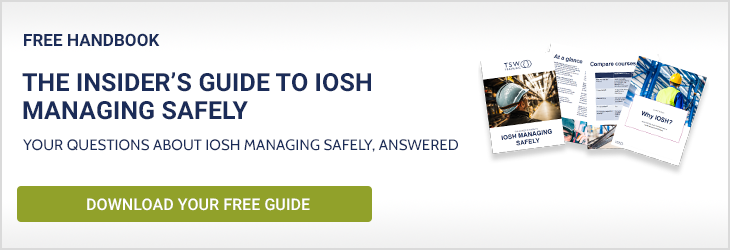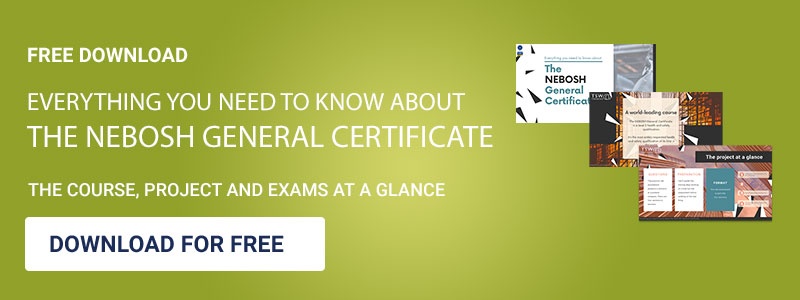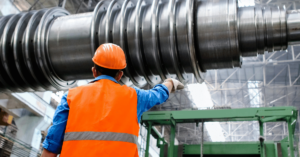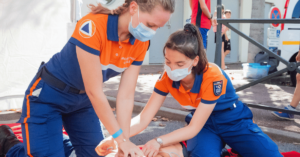According to the Health and Safety Executive (HSE), there were 1.7m working people with a work-related injury or illness in the UK in 2021. [1]
The cost of workplace injuries and illnesses to business is high, with sick days slowing down production, and fines being distributed for poor health and safety processes.
Key points:
- Your workplace will have its unique health and safety challenges to overcome, but there are common issues familiar to every business, small or large. We’ve detailed 17 of the most common below.
- By investing in exceptional health and safety training, the number of injuries will reduce, as well as the risk of litigation for your business.
- We recommend the IOSH Managing Safely for your Level 2 qualifications and the NEBOSH National General Certificate for your Level 3 qualifications.
What are the benefits of health and safety training?
If you invest in exceptional health and safety training, you’ll see benefits and progress almost instantly, curbing the number of people hurt on the job and therefore, the risk of litigation.
However careful you are, you can always count on the unexpected. Accidents, minor or serious, will happen. The right training doesn’t just show you how to prevent, it also shows you how to respond and react so they don’t happen again.
Most Common Health & Safety Issues At Work
Your own workplace will have its unique challenges to overcome, but there are health and safety issues familiar to every business, small or large:
- Temperature, light and air conditioning
- Harmful surroundings and hazardous substances, like asbestos
- Workstation health and safety, like computers and other display screen equipment (DSE)
- Manual handling
- Noise and sound exposure
- Slips, trips and falls
- Handling heavy machinery, tools and equipment
It could be these hazards, or something more specific to your company, that creates health and safety issues if they go unmanaged.
What are the 17 tell-tale signs that your business needs health and safety training?
#1. A high rate of work-related injuries
Self-reported, non-fatal workplace injuries reached 441,000 in 2020/21.
Certain accidents are familiar to every workplace, whether your staff operate a crane, or sit at a desk for most of the day.
Here are the most common dangers in the workplace, according to the HSE, reported across all industries.
- Slips, trips and falls on one level: 33%
- Handling, lifting or carrying: 18%
- Struck by a moving object: 10%
- Violence: 8%
- Fall from a height: 8%
Your health and safety objectives should focus on eliminating the most common workplace injuries.
#2. There are life-threatening risks at work
Unfortunately, there have been many cases whereby people have lost their lives at work. And for this reason alone, it’s vital for health and safety to be taken seriously.
If there are a life-threatening health and safety risks at work, you must submit a RIDDOR report if a member of your staff gets injured and they:
- Die
- Break a bone, except thumbs, fingers and toes
- Need amputation
- Lose their sight
- Suffer a crush injury to the head or torso with damage to the brain and internal organs
- Sustain a serious burn that covers more than 10% of the body, or damages the eyes, respiratory system and internal organs
- Lose consciousness after a head injury or asphyxia
- Need resuscitation
- Get hypothermia
*You must make sure that accidents are correctly recorded, and you must report an injury at work if it causes your employee to take more than seven consecutive days of sick leave.
If your employee’s injured, but it doesn’t fall into a RIDDOR report category, you must still make a record of it. You must keep an accident book under the Social Security (Claims and Payments) Regulations, 1979.
If you follow health and safety legislation carefully, you’ll sidestep legal action and compensation claims, assuring the future of your business and the wellbeing of your staff.
Quality health and safety training, like the IOSH Managing Safely or NEBOSH General Certificate, will show you how to safely handle accidents and control hazards, however dangerous they are.
*There will be an increased number of accidents in the workplace following any kind of health and safety training, but it’s a positive trend. It shows the learning has transferred and that your staff are accurately reporting the accidents, hazards and risks they encounter, which were uncontrolled before the training.
Download TSW Training’s free guides to the IOSH Managing Safely Course and NEBOSH General Certificate today
IOSH Managing Safely Course

NEBOSH General Certificate

#3. Work-related ill health is common
Work-related ill health kept 1.7 million people off work in 2020/21 and half of those were suffering from stress, depression, or anxiety.
As the saying goes, ‘prevention is better than cure’.
If you send your staff on the IOSH Managing Safely course, they’ll learn how to identify hazards that contribute to anxiety, and other conditions, including musculoskeletal injuries.
They’ll have the initiative to flag and control hazards that are contributing to a high level of work-related ill health and absence.
#4. You work with harmful substances
The HSE estimates there will be 2,500 mesotheliomas (cancer) deaths every year until the end of the decade, linked to exposure to harmful substances at work.
It’s not hopeless – if you work with harmful substances and fumes, you can take steps to protect your staff.
Health and safety training that contains risk assessment training (both IOSH and NEBOSH do), will show your staff how to reasonably predict foreseeable risks, like occupational asthma, lung disease and mesothelioma.
All good health and safety training courses will walk through risk controls that can be dropped into working environments to safeguard against harmful substances that could cause respiratory conditions:
- Is there physical signage alerting staff to the substance and instructing them how to behave?
- Are health and safety procedures placed on the surfaces around the substance?
- What equipment and machinery could be used to reduce the risk?
- Is there a less hazardous substance which could be swapped in?
- Could engineering solutions be employed to contain fumes?
- Are staff wearing enough protective clothing (PPE)? For example, masks, goggles, gloves, and hazmat suits
Identifying opportunities to outsource to a specialist is another outcome of successful health and safety training. For instance, which chemicals and pollutants could be very harmful to your staff?
#5. The accident book is full of manual handling injuries
There were 470,000 cases of work-related musculoskeletal disorders reported in 2021.
If a member of your staff has a musculoskeletal disorder, they have a medical condition that’s affecting their bones, joints and muscles that prevents them from working.
Musculoskeletal disorders should be on your radar if your team are involved with manual handling. You can prevent hazardous manual handling by reviewing your processes and operations, to make sure you’re controlling how much of your stock needs to be moved by hand.
Your staff must learn how to complete a risk assessment to identify how likely and harmful a hazard is.
They’ll have to ‘describe the harm‘ by looking at the severity of the hazard and decide how likely someone would be to get hurt, or die, if it was left as it is.
Manual handling risk assessment example
A warehouse operative is lifting large boxes from a pallet and onto the warehouse floor.
Your risk assessment must evaluate and describe how the hazard could injure them and the implications if they’re hurt straightaway, what the long-term considerations are, and if the injury could be life-ending.
Immediate musculoskeletal injuries as a result of manual handling could be bone fractures, pulled muscles and bruises. They might need bed rest, physiotherapy and numerous appointments with doctors and healthcare professionals.
The long-term implications could be torn ligaments and tendons, which need specialist therapy and treatment which extends beyond a few days off and an appointment here and there.
By assessing the risks associated with manual handling, recording and taking steps to control them, you’re:
- Limiting the risk of manual handling injuries
- Reducing the likelihood and cost of sick leave
#6. Cases of workplace stress, anxiety and depression are increasing
822,000 workers reported that they felt stressed, depressed or anxious.
Neither the IOSH Managing Safely or NEBOSH General Certificate have a specific module about mental health, however, the health and safety process they both apply to your business could help to alleviate pressure and stress at all levels.
If you can improve workplace mental health and wellbeing, you could prevent work-related absence and keep your workforce happy.
In 2020/21, there were 451,000 new cases of work-related stress, depression, and anxiety – an increase of 104,000 on the previous year.
A health and safety manager’s mental state is so important because their reporting may not be accurate if they’re feeling under pressure. As a result, you won’t have peace of mind that the business is protected.
Use IOSH Managing Safely to build an open health and safety culture where everyone is accountable for the wellbeing of their colleagues and the wider business.
With all eyes open to hazards, and a solid reporting process in place, you’ll alleviate the stress felt by health and safety managers.
Further reading:
#7. You’re slow to find and apply protective measures
If a member of your staff loses their life at work due to your health and safety negligence, it could call time on your trading. The industries with the highest number of annual fatalities in 2020/21 were:
Industry and the number of annual fatalities
- Construction: 30
- Agriculture, forestry and fishing: 22
- Manufacturing: 22
- Transportation and storage: 16
- Wholesale, retail, motor repair; Accommodation and food: 11
- Administration and support services: 12
Health and safety training helps your team spot and control life-ending hazards, for instance:
- Falling from a height
- Being struck by a moving vehicle or object
- Contact with moving machinery
- Being trapped by something collapsing or overturning
During risk assessment training, your staff will use the 5×5 risk matrix and learn how to assess the danger posed by an untreated risk.
They’ll work out an inherent risk score by multiplying the likelihood score and a consequence score.
If the IOSH (5×5) risk calculator assigns a high score to a hazard, you must take immediate action to control it and ultimately, save lives.
For example, if the likelihood score was five (5) – very likely – and the consequence score was five (5) – catastrophic, deathly – the inherent risk rating would be 25.
Likelihood scores
| Score | Description |
|---|---|
| 1 | Very unlikely |
| 2 | Unlikely |
| 3 | Fairly likely |
| 4 | Likely |
| 5 | Very likely |
Consequence scores
| Score | Description |
|---|---|
| 1 | Insignificant, no injury |
| 2 | Minor, but needs first aid |
| 3 | Moderate, three days absence |
| 4 | Major, more than seven days of absence |
| 5 | Catastrophic, death |
If an employee dies at work you must report it to the police and HSE, even if your employee is working away from your workplace.
#8. You’re worried about prosecution, fines and sentencing
The HSE issued £26.9m in fines for health and safety offences in 2020/21.
If your health and safety staff and the wider organisation comply with the Health and Safety at Work Act 1974, you’re not at risk of prosecution.
However, the Management of Health and Safety at Work Regulations 1999 does ask you to keep your staff’s health and safety skills up to date – regular, recognised training is a way to do that.
The IOSH Managing Safely qualification is regulated by IOSH, a widely respected and well-known chartered body. Similarly, the NEBOSH General Certificate is regulated and maintained by awarding examination board NEBOSH, which is known world-over for its exceptional standards.
Once they have the qualification, it never expires, but to comply with those 1999 regulations, you can send your team on refresher courses every three years, or move them onto further health and safety education.
Both IOSH and NEBOSH have an education framework, designed to keep health and safety workers informed about the changing landscape of their industry and deepen their knowledge.
If your company turns a blind eye to hazards and deals with accidents as they happen, that’s not a safe situation for you or your business to be in.
Quickly get control of a high-risk environment by challenging lazy habits and tired processes head-on.
#9. There’s no visibility across the business
You’re not involved with all areas of the business, so there are hazards you can’t see in rooms you never go in.
That’s a dangerous position for a health and safety manager to be in – you need to have a very precise knowledge of your workplace, so you can describe it and clearly discuss hazards and apply controls in a risk assessment.
Health and safety training helps you to routinely notice the function and size of the space, and how many people use it. You’ll schedule timely, formal inspections and you’re alert for hazards throughout the day.
#10. There’s no trust that processes are being followed
You need to be in a position where the health and safety processes guide the actions of your staff, even if you’re not there to supervise.
Health and safety training will teach you that even in a high-risk workplace, not every employee will run into every hazard, but there needs to be rules and policies in place to guide them if they do.
You need an awareness of which job roles are exposed to various risks, if visitors access the space near the hazard, and if anyone accesses the area at different times of day, for instance, shift workers, cleaners and maintenance staff.
Download TSW Training’s free guides to the IOSH Managing Safely Course and NEBOSH General Certificate today
IOSH Managing Safely Course

NEBOSH General Certificate

#11. There is no communication about hazards
“If hazards aren’t identified or reported by employees, it is near impossible to keep a busy workplace safe. This puts significant pressure on those responsible for health and safety, and presents some serious risks for the organisation and its people,” explains our commercial director, Matthew Channell.
Showing employees how to tackle a hazard when they find it will get the whole organisation working together to improve workplace safety and not overstretch health and safety managers.
#12. You don’t know who is responsible for health and safety
When accidents happen, it’s anyone’s guess who’s going to sort out the hazard. Reporting health and safety issues fail at the first hurdle. You might find that:
- Dangerous hazards which need urgent attention, aren’t dealt with quickly enough
- Superfluous or extreme controls are applied to trivial hazards
“Team leaders, supervisors and managers not understanding their legal duties and responsibility for health and safety creates dangerous situations and risk of litigation,
“If there’s a lack of collective responsibility, health and safety managers often feel like they are in a party of one, and that’s a lonely, frustrating place to be. In my experience, health and safety professionals would like a few more allies in their fight to develop safety first cultures.
“IOSH courses for example, can improve buy-in through a better understanding of importance and roles. Once every person understands they have a responsibility for health and safety, regardless of role, we will be in a better place.” – Matthew Channell, Commerical Director
You need to learn how to assign a score to a hazard, as shown in the 5×5 risk matrix above, so you can accurately describe how likely an accident is and how severe the consequences would be if you did nothing.
Then you can apply controls re-score and recommend how to appropriately control the hazard and the date when it needs to be resolved. You can also assign the task of controlling the hazard to a specific person, so you’re reducing the chance of it causing trouble again.
#13. Not all injuries are taken seriously
You need to know the circumstances of every injury, no matter how small and you need to learn how to assess the severity of the hazard. If you didn’t control a hazard, would it hurt your staff so much so they’d need ongoing treatment? Could it end their life?
A tiny scratch could lead to blood poisoning and sepsis, for instance, but it’s up to you decide how likely that is.
With IOSH’s training, you’ll help your business to reduce staff sick days by decreasing the risk of injury-related absence too.
#14. You’ve been told to save money
Health and safety can improve and protect your business income and financial security.
By reducing the risk of liability and investing in health and safety controls that make the workplace safer long-term, you’re preventing needless spending.
The IOSH Managing Safely course and NEBOSH General Certificate training will show you how to identify, record and report hazards across your entire business and measure how successful the controls are. When you return to work, you’ll be able to prove that your approach to health and safety is saving the business money.
Download TSW Training’s free guides to the IOSH Managing Safely Course and NEBOSH General Certificate today
IOSH Managing Safely Course

NEBOSH General Certificate

#15. You don’t have any accidents at work
Or, are they just not recorded? Turning a blind eye to accidents and hazards is irresponsible. You could face legal action, compensation claims, and place your staff and business in serious jeopardy.
In the months after your training, your senior managers might be alarmed by a sudden spike in the number of accidents in the workplace – this is evidence that you’ve learnt to accurately document the accidents going un-noticed. It’s a good thing.
The spike is a true reflection of how many accidents are taking place and how much work you’ve got to do to control them.
#16. There’s no budget for health and safety training
Training is a soft risk control that raises health and safety awareness throughout the business. If everyone is keeping an eye open for hazards – and knows how to report them correctly – the health and safety culture should improve.
Health and safety often comes at a cost, but it’s a necessary one. If your workers attend the IOSH Managing Safely, your financial officers will have a better understanding of the value that health and safety brings.
IOSH is unusual in that its qualifications don’t expire, but there are refreshers designed to get you up to speed on new legislation and health and safety changes – it’s important to get your top-up training factored into the budget.
Once you’re qualified, you must keep your skills sharp to prove you’re fulfilling your role with appropriate care.
#17. “Health and safety is boring”
“Health and safety, unfortunately, has a boring reputation,” says Matthew Channell, Commercial Director.
It’s difficult to get your people invested and caring about something they find tedious and unchanging.
But if they feel like they’re making a positive difference, that encourages a caring safety culture and makes the environment safer for everyone.
Delve deeper into the Health & Safety courses we offer at TSW Training:
- NEBOSH National General Certificate
- IOSH Managing Safely Course
- IOSH Working Safely
- All NEBOSH Courses
- All IOSH Courses
- and more
Or, if you’d prefer to speak to one of our friendly team to discuss your specific health and safety training requirements, get in touch today.
[1] According to HSE’s Health and Safety at Work statistics 2021







